
Advertising on Amazon: How to Get Explosive Amazon Sales via PPC Ads


Table of Contents
- Introduction
- What is Amazon PPC?
- Should I Advertise on Amazon?
- Amazon Advertising Costs
- Why PPC Ads Are Important for Your Amazon Business
- Types of Ads Available on Amazon
- Sponsored Products
- Sponsored Brand Ads
- Product Display Ads
- Store Ads
- Video Ads
- How to Optimize Your Amazon Ads: 6 Tips
- Create Product Category Campaigns
- Design Compelling Ad Copy
- Make the Ad Copy Highly Specific
- Bid on Popular Competitor Brands
- Use Different Ad Formats
- Use Negative Keywords
- How Do I Set up an Ad Campaign on Amazon Seller Central?
- Navigate to the Appropriate Area
- Set Up Your Campaign Budget, Duration, and Targeting
- Name Ad Group
- Select Your Products You'd Like to Run Ads For
- Set Your Campaign Bidding Strategy
- Save and Finish
- Additional Advertising Strategies
- Amazon Stores
- Amazon Attribution
- Amazon Live
- Conclusion
Introduction
Amazon is the world’s largest e-commerce platform, so being able to advertise directly on Amazon is a no-brainer for any Amazon seller. Understanding the different types of Amazon ads and their unique purposes is crucial for sellers looking to enhance their advertising efforts. Depending on their marketing goals and target audience, sellers can utilize a combination of these ad types to maximize product visibility, increase sales, and drive business growth on the Amazon platform.
Due to changes in Amazon rules, Amazon advertising is now also the principal manner that sellers utilize in order to launch new products on the platform. You can access your Amazon advertising control center inside of your seller central account, or you can use tools such as Adtomic or Pacvue in order to manage or even automate your PPC campaigns.

Outclass Your Competitors
Achieve More Results in Less Time
Maximize your results and drive success faster with Helium 10’s full suite of Amazon and Walmart solutions.
Sign Up for FreeWhat is Amazon PPC?
Pay-per-click (PPC) advertising on Amazon is exactly what it sounds like – you get charged every time a customer clicks your ad, sale or no sale. It’s a pay-to-play environment where visibility comes at a very real cost.
Thankfully, Amazon and Helium 10 provide third-party sellers with user-friendly advertising tools to launch and manage various PPC campaigns in just minutes. How much you’ll actually pay per click depends on the specific ad format, the high-search volume keywords you’re bidding on, and overall competition levels within your product category.
While the platform makes setup easy, monitoring and optimizing for efficiency requires close attention to Amazon’s provided performance metrics:
- Clicks: The raw number of times customers clicked your ads, adjusted for any invalid/accidental clicks within about 3 days.
- Impressions: How many times your ads were displayed to shoppers browsing Amazon’s real estate.
- Spend: The total amount of click charges racked up per ad campaign over its lifetime.
- Sales: How many actual product purchases were generated within 1 week of those ad clicks.
- ACoS: Advertising Cost of Sales measures ad spend as a percentage of revenue attributed to your campaigns. Calculate by dividing total ad spend by total ad-driven sales.
- ROAS: The inverse of ACoS, this Return on Ad Spend metric shows attributed sales dollars per $1 invested. A 5x ROAS means $5 in revenue for every $1 spent.
Diligently monitoring and optimizing against these metrics is essential for campaigning profitably and avoiding a leaky PPC money pit. While there’s undoubtedly a learning curve, eventually you’ll be able to read and react to the data like a seasoned pro.
For sellers more interested in the product than PPC, though, the smart play is often outsourcing campaign management to an experienced Amazon advertising specialist—or Amazon marketing agency—who can stay laser-focused on achieving maximum return on that ad investment.
Should I Advertise on Amazon?
Got a physical product ready for online shoppers to snatch up? Then the answer is a resounding yes – you should be advertising on Amazon! The e-commerce giant provides yet another channel to expose your offerings to a massively heightened audience and inevitably drive more buyers.
If you’re feeling apprehensive, start small with a product you know has proven online sales traction. For example, if you’re a sports gear seller and tennis rackets have historically been your top digital mover, kick things off by running ads for your bestselling racket model. Once you see that positive ROI, you can expand the campaign to incorporate more brands and racket varieties.
Another compelling incentive to advertise on Amazon? Doing so can actually improve your organic search rankings on the platform. Studies have repeatedly shown that successfully driving paid advertising clicks and sales around particular search terms create a powerful flywheel effect.
As your “Amazon AdWords” campaigns pump up a product’s overall sales velocity, the algorithmically-driven ranking system takes note, recognizing your listings as highly relevant for customer queries around those top-performing keywords. Before long, you’ll find yourself steadily climbing toward premium organic placement as Amazon increasingly surfaces top-selling items higher up on key search result pages.
To maximize your PPC ad performance and organic ranking boosts, leverage Helium 10’s Adtomic. This tool provides optimization recommendations based on deep data analysis across your campaigns. Adtomic highlights winning and losing keywords, top-converting ads, wasted spend areas, and opportunities for driving more impressions – all within a streamlined dashboard. This AI-driven PPC management tool makes it seamless to iterate and rapidly improve your advertising ROI over time.
So not only can investing in Amazon’s paid advertising boost your product sales, but it could simultaneously elevate your organic rankings as well. Does it get any better than killing two birds with one stone?
Amazon Advertising Costs
So what kind of investment are we talking about for advertising on the Amazon juggernaut? According to analytics from Rob Sieracki at Practical Ecommerce, the average cost-per-click on Amazon ads rarely exceeds $0.35. That makes it a more cost-effective CPC play than search ads on AdWords or Bing while being on par with some of the lowest CPCs for Facebook ads and the Google Display Network. Not too shabby considering the high commercial intent behind searches on Amazon!
Why PPC Ads Are Important for Your Amazon Business
There’s no denying the intensifying competition gripping the Amazon marketplace year after year – a trend that has turbocharged Amazon’s booming advertising business. Just look at the staggering numbers from the past year alone, with Amazon’s ad revenue soaring 32% from $21 billion to a meteoric $31 billion.
Pay-per-click (PPC) advertising has become the go-to strategy for sellers and brands big and small, with a whopping 79% of first-party vendors and 71% of third-party merchants tapping into at least one Amazon PPC ad format. While having the world’s consumers flock to Amazon is a massive opportunity for sellers, there are also valid concerns about the downsides of such explosive marketplace growth.
Nearly 6 in 10 Amazon sellers worry the increased competition will trigger a race to the bottom on pricing. An equal number of people fret over rising ad costs eroding their profits on Amazon. But despite those escalating ad fees, running profitable PPC campaigns is still an achievable goal – it just requires some strategic savvy.
Advertising is especially crucial when launching and relaunching product listings. Simple keyword or product targeting campaigns provide the audience exposure you’d never get organically, jumpstarting your ability to skyrocket up the search rankings. Pair that PPC jumpstart with an excellent product, compelling product photography, and a finely-tuned listing, and you’ll be converting ad clicks into sales in no time. Those initial ad-driven conversions then supercharge your organic keyword rankings for a compounding sales impact.
Little wonder then that 32% of merchants cite Amazon’s PPC advertising as a make-or-break factor for seller success. Let’s take a look at the different ad formats at your disposal, whether you’re green to Amazon PPC or a seasoned pro.
Types of Ads Available on Amazon
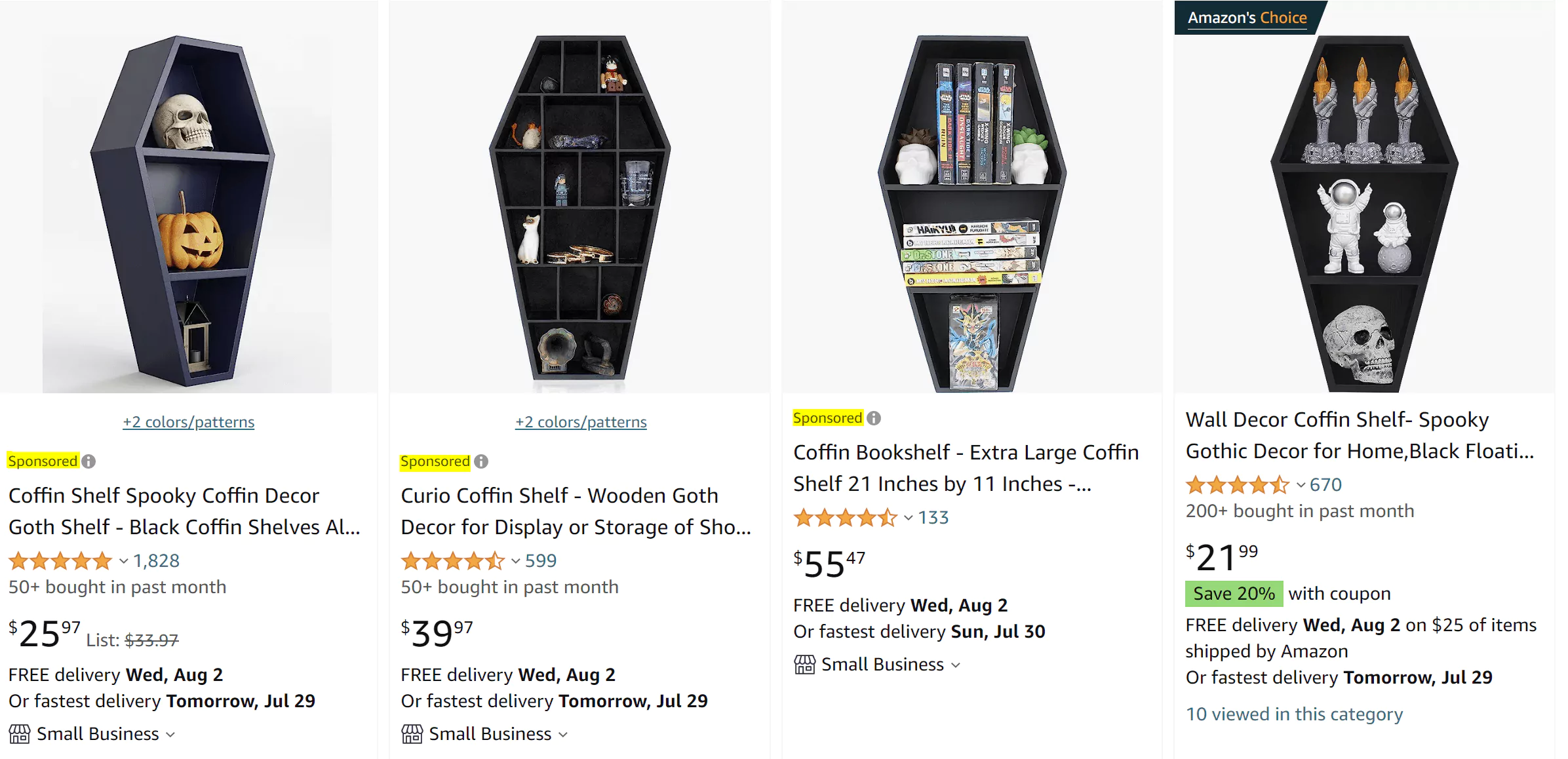
Sponsored Products
If you’re only going to run one type of Amazon Ads campaign, make it Sponsored Products. These paid listings are ubiquitous across Amazon’s search results and product detail pages – making them a must-have for capturing high-intent shoppers.
With Sponsored Products, you can laser-focus your targeting by bidding on specific keywords and even your competitors’ product ASINs. This precision control allows you to insert your offering directly in front of motivated buyers who are actively researching that exact product category or brand.
These ads seamlessly blend into Amazon’s native experience, transitioning clickers straight to your product detail page primed to convert. From there, it’s just a matter of your rockstar listing and pricing doing its job to seal the deal.
Monitoring metrics like clicks, CPC, spend, attributed sales, and ACoS (advertising cost of sales) within the campaign manager enables continuous optimization. You can quickly double down on the top-performing targeted keywords and ASINs while cutting waste on the under-performers.
With their prominent placements and proven conversion prowess, Sponsored Product campaigns are a pillar of virtually every successful Amazon advertising approach. Stake your claim on those precious search result ad positions to ensure maximum visibility when shoppers are locking in their purchase decisions.
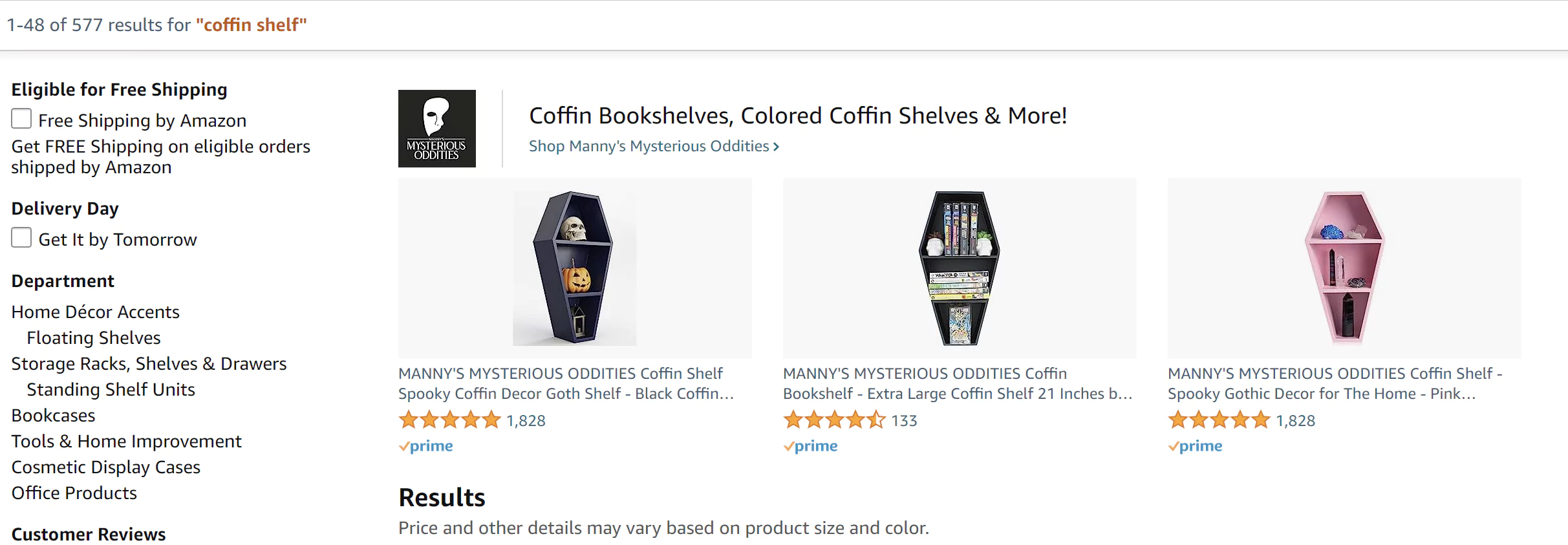
Sponsored Brand Ads
While Sponsored Products put the spotlight on individual listings, Sponsored Brands take a more holistic brand-building approach. These headline search ads are all about reinforcing your brand identity and showcasing your product portfolio.
With Sponsored Brands, your creative gets premium real estate at the top, bottom, and alongside those coveted Amazon search result pages. You’ll feature eye-catching tiles for up to three of your hero products alongside a custom brand logo and headline. This top-of-funnel visibility ensures your brand makes a powerful first impression on motivated shoppers.
Just like Sponsored Products, you can meticulously dial in your targeting by bidding on specific keywords and competitor product ASINs. Whenever a customer searches for those terms, your multi-product brand ad will be waiting.
But Sponsored Brands also extend your visibility beyond just search results. Your branded product showcase will also appear complementarily on related product detail pages across Amazon. With a single campaign, you capture high-intent shoppers through their entire quest.
For brands looking to solidify their presence and credibility on Amazon, Sponsored Brands are an indispensable advertising pillar. This ad format equals high-impact brand exposure wrapped around an incredibly targeted, full-funnel shopping journey that drives brand awareness and conversions simultaneously.
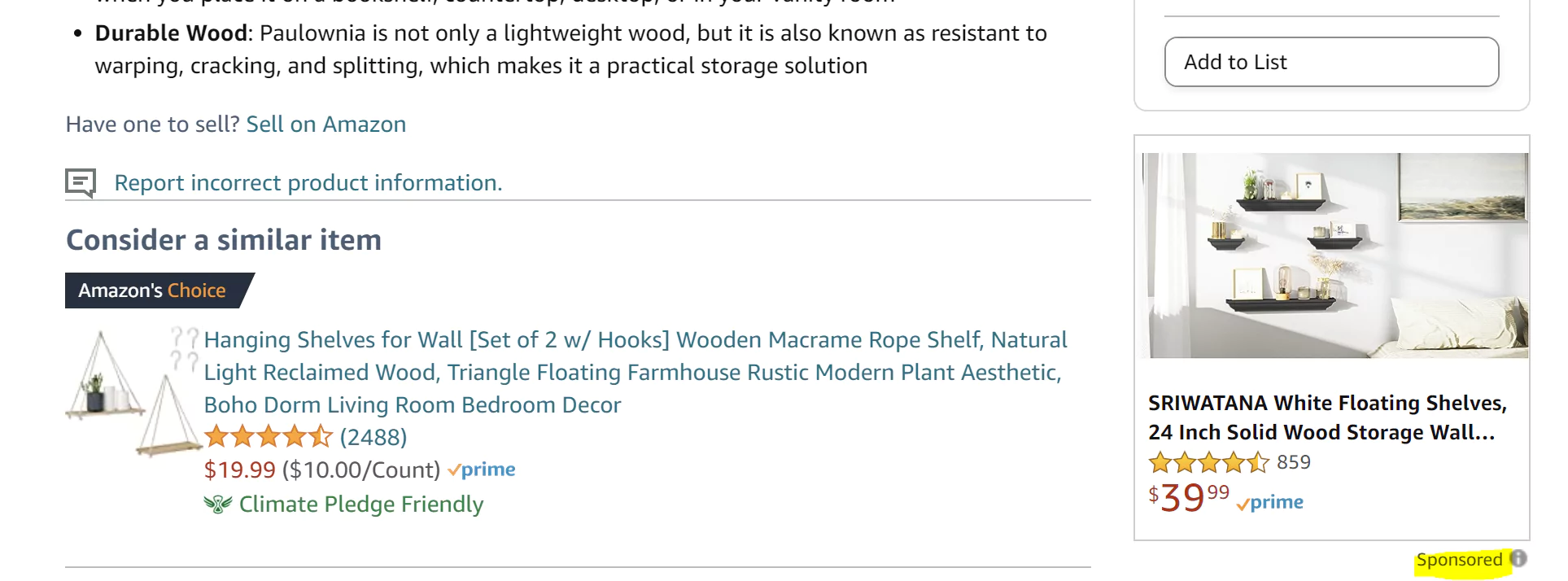
Product Display Ads
While Sponsored Products and Sponsored Brands prioritize capturing high-intent search traffic, Product Display Ads—also known as Sponsored Display ads—unlock powerful merchandising possibilities across the wider Amazon browsing experience. The primary objective? Surfacing your products and brand at precisely the right moments to cross-sell or upsell existing customers.
With granular audience targeting parameters, you can strategically serve these visual product listings to specific customer segments based on interests, shopping behavior, viewed products, and more. Think of it like the Amazon version of the Google Display Network; you’re breaking through the limitations of search-based marketing to get in front of qualified prospects through a variety of placements.
Your engaging product/brand creative could appear in sidebars alongside related listings, on reviewing pages after purchases, below search results, and even within transactional follow-up emails like abandoned cart reminders and recommendations. The possibilities for catching shoppers’ eyes throughout their journey are virtually limitless.
And the audiences you can target extend far beyond just product sellers. Amazon’s display platform represents an effective outbound marketing channel for businesses of all stripes to build awareness, promote offers, and win new customers through compelling visual ads served across premium Amazon inventory.
For brands focused on maximizing lifetime customer value, product display ads present an invaluable way to introduce complementary offerings and nurture high-value customer relationships through the entire shopping lifecycle on Amazon’s insanely popular online real estate.
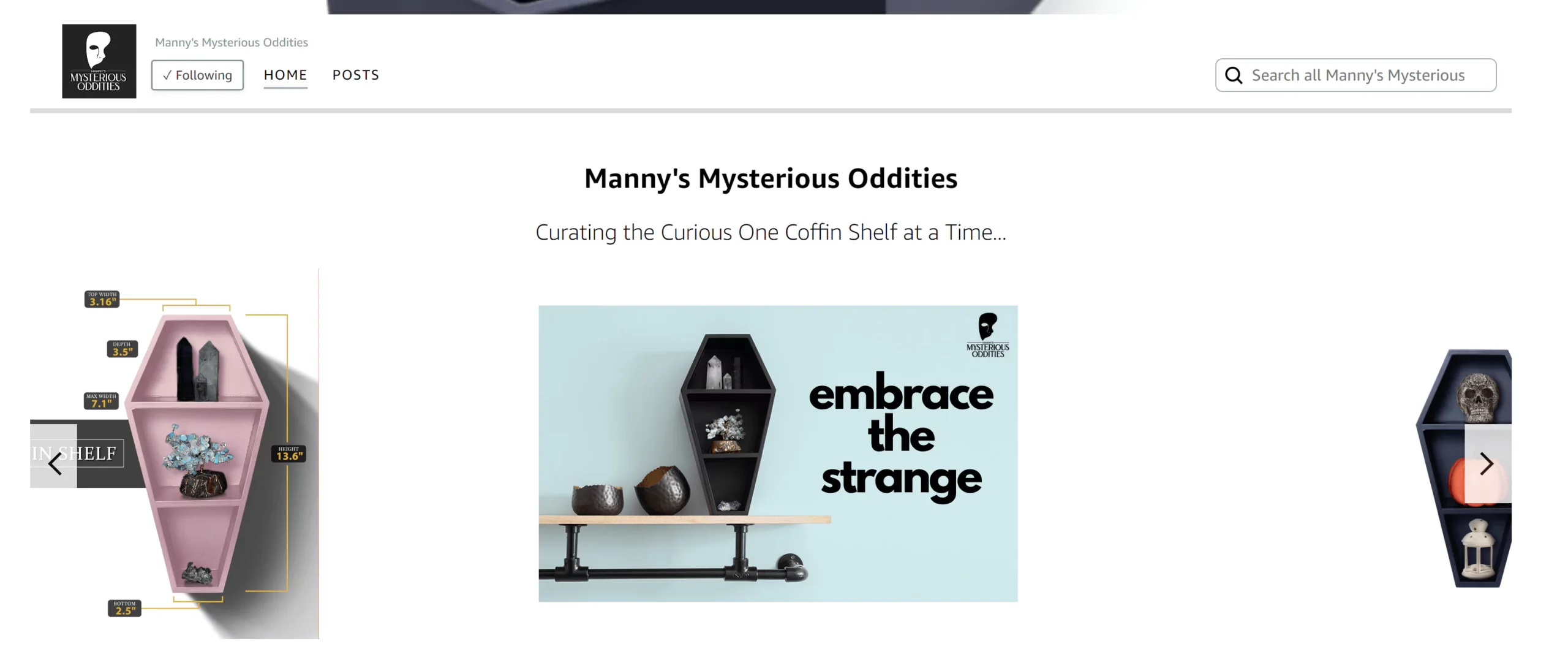
Store Ads
For sellers who’ve invested in building out a rich, multimedia Amazon storefront, the Store Spotlight ad format represents a prime opportunity to funnel high-intent traffic directly into that owned brand experience.
These top-of-search placements are all about driving discoverability of your curated Brand Store hub and keeping shoppers engaged within your Amazon ecosystem. This allows you to promote your Brand Store alongside eye-catching tiles for up to three of your hero product listings.
By sponsoring relevant keywords, your Store Spotlight ad grabs prime real estate prominently above the search results when customers are actively looking for products in your category. With a single click, you can usher them into an immersive, visually-rich brand world you fully control; no more getting lost amongst the generic Amazon sea of competitor listings.
Inside your Brand Store, shoppers can frictionlessly browse and self-educate on your full product catalog and unique brand story through a website-esque hosted experience you customize end-to-end. It’s the ideal environment for nurturing customers from initial awareness all the way through to loyal repeat purchasing.
For brands who’ve put in the effort investing in an Amazon Brand Store asset, Store Spotlight ads are a no-brainer for driving sustained traffic into that high-margin-owned marketing channel. Get maximum mileage from your Store by meeting customers at their highest point of interest.
Video Ads
Video ads on Amazon offer the same visual storytelling potential as traditional display ads, but swap static images for rich multimedia that truly brings products to life. Yet this format remains one of the most overlooked and under-harnessed opportunities in Amazon’s advertising ecosystem.
While challenging to execute effectively, compellingly creative video promotions stand to reap massive rewards in terms of capturing attention and driving conversions. It’s an advertising medium that, when done right, can initiate much deeper emotional connections between brands and customers.
Just look at YouTube as a prime example. Video ads on that platform consistently deliver the strongest conversion rates across the entire digital advertising landscape. There’s an inherent ability for punchy, narrative-driven video creative to break through banner blindness and forge more meaningful impressions.
Of course, producing high-quality video ads worthy of commanding that engagement requires serious planning, resources, and execution chops. Mediocre, forgettable videos will just blend into the noise. But brands willing to invest in brilliant storytelling packaged as bite-sized video ads position themselves to be front-and-center whenever Amazon shoppers are in an explorative, discovery mindset.
For sellers not currently taking advantage of Amazon’s video ad inventory, you’re missing out on a powerful branding mechanism and captive audience. With the right creative approach and targeting parameters, video promotions could be your most valuable weapon for driving product awareness, desire, and sales.
How to Optimize Your Amazon Ads: 6 Tips
With the sheer volume of products vying for attention on the Amazon marketplace, we don’t blame you for questioning whether advertising on the platform can realistically move the needle. Luckily, there are proven tactics to help your offerings cut through the noise and reach motivated buyers. It just requires taking a strategic, informed approach to your Amazon ad campaigns.
Check out the six tips below to get started:
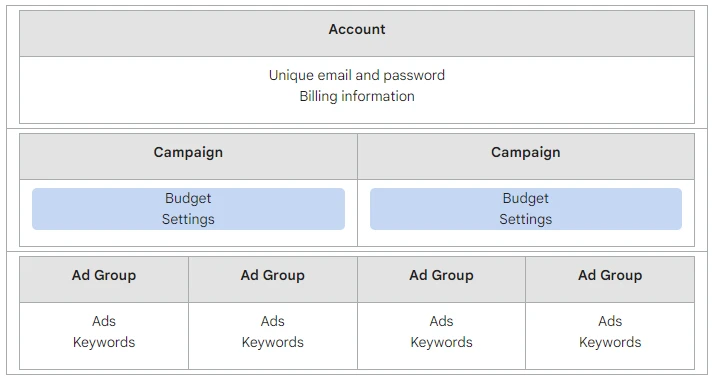
Create Product Category Campaigns
For those familiar with Google AdWords campaigns, this concept will feel like second nature. You can apply those same organizational principles to structure efficient campaigns and ad groups within Amazon’s advertising platform. The optimal strategy is creating separate campaigns for each main product category you sell, then building out more granular ad groups underneath.
For example, let’s say you’re in the women’s activewear space. You might kick things off with three campaigns targeting your bestselling product lines:
- Women’s workout pants
- Women’s workout tops
- Women’s sports bras
Within each of those campaigns, you’d then create more specific ad groups. So, for the workout pants campaign, you could have ad groups for yoga pants, running pants, and lounge pants.
From there, you’ll build out a relevant 15-30 keyword list for each individual ad group. Finally, you’ll craft a dedicated ad creatively tailored to each keyword grouping within those ad groups.
Maintaining a tight, logical account structure ensures your ads stay hyper-relevant to user searches, which translates to lower costs and higher ROI.
This best practice is absolutely critical for maximizing your Amazon advertising performance and profits. Those already versed in AdWords optimization will have a head start applying these principles to Amazon’s platform.
Design Compelling Ad Copy
Of course, ensuring your ad copy accurately represents what you’re selling is Advertising 101. But on a platform as crowded as Amazon, you’ll need to go the extra mile to capture attention. Inject some creativity, even humor if appropriate for your brand voice, to help your promotions stand out from the pack amidst Amazon’s dense search results.
Creating a sense of urgency can also compel clicks. If you’re running a limited-time sale or promotion, be sure to highlight those details front and center in your ad copy. An approach like “Summer Clearance: Up to 60% Off Performance Shorts – This Week Only!” immediately conveys value and scarcity.
With customers’ eyes glazing over from ad fatigue, breaking through the noise requires punchy, distinctive ad copy that quickly articulates a compelling value proposition. Don’t blend in! Instead, give buyers a reason to pause their scroll and take action on your promotion.
Make the Ad Copy Highly Specific
Vague ad copy is the easiest way to get ignored and waste your ad spend. Your promotions need to be hyper-specific about what’s actually being sold. If you’re hawking water bottles, it’s important for customers to know the ounce/cup capacity, whether it’s BPA-free, and how many hours it’ll keep liquid icy cold after one glance at your ad.
Sure, packing all those critical details into a tight ad headline and body copy is challenging. But you’ve got to strategically prioritize and jam in the most compelling, need-to-know info about your product’s key differentiators and value props.
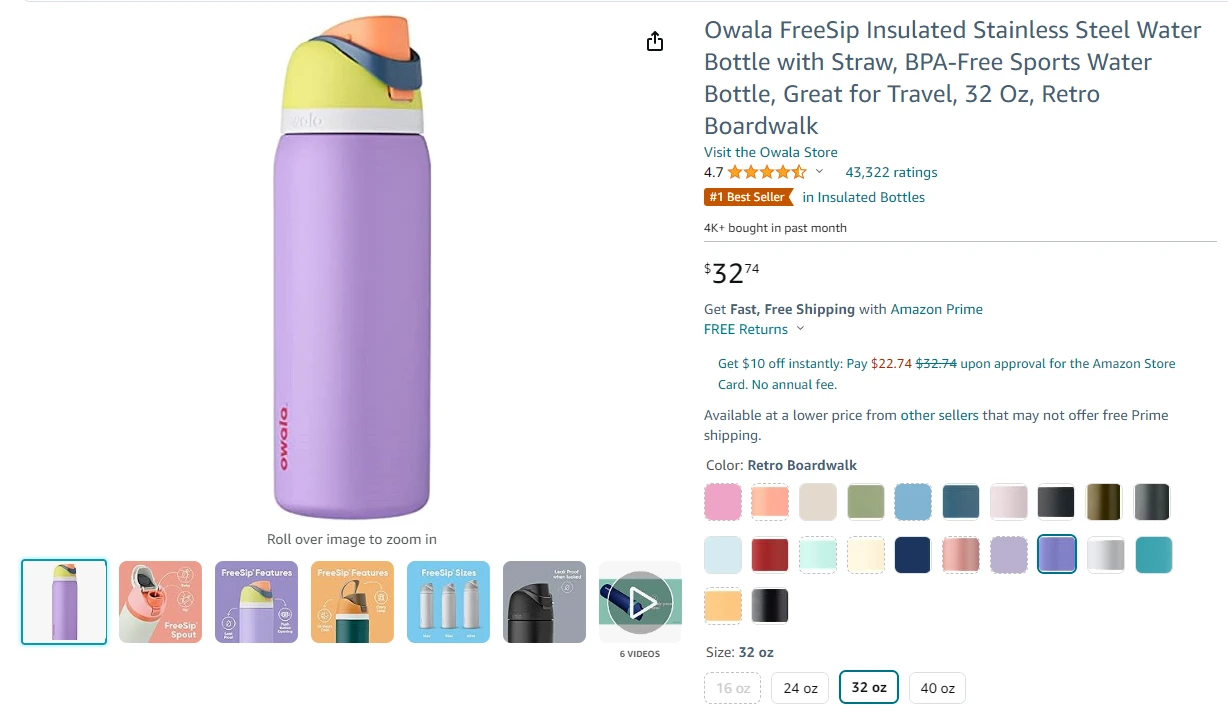
This water bottle ad is a prime example of doing it right! The headline alone tells customers the exact weight, additional items that make it stand out from competitors, and everything else included with the purchase.
In Amazon’s crowded advertisement ecosystem, being even slightly vague is a surefire way to get overlooked. Laser-focused specificity that quickly communicates what sets your product apart is mandatory for capturing prospect attention and converting clicks to sales.
Bid on Popular Competitor Brands
When building out your Amazon keyword targeting lists, don’t sleep on your biggest brand name competitors. If you’re selling backpacks, you better be bidding on searches for juggernauts like “L.L. Bean backpacks” and “Northface backpacks”. These are the household names that dominate search volume and buyer mindshare in the category.
Strategically piggybacking on these branded searches allows you to insert your product in front of motivated shoppers at precise high-intent moments. While they may be initially seeking out those mainstream brands, your slick ad copy and attractive offering can divert eyeballs and purchases to your fresh, lesser-known backpack line.
To identify your top competitors to target, simply run some broad product searches like “backpacks” on Amazon itself. Take note of the brands monopolizing the first page of results – those are the legacy players you’ll want to relentlessly outbid for those branded keywords. This “piggyback play” garners valuable visibility and siphons off sales that may have otherwise been left on the table.
Use Different Ad Formats
Sponsored product ads may seem like the lowest-hanging fruit for driving quick returns, but don’t sleep on headline search ads either. This ad unit could very well attract higher-intent shoppers primed for loyal, repeat purchasing down the line.
The smart play is experimenting with all three of Amazon’s core ad formats – sponsored products, headline search, and product display ads. Let the performance data guide your PPC optimization strategy. Once the stats can paint a clear picture of which unit is delivering the highest ROI, you can then reallocate budget to double down on the winners.
Too many brands fixate solely on sponsored products for the short-term sales bump while overlooking the long-term customer acquisition value that headline search ads can unlock. An upfront testing period allows you to scientifically determine the right ad mix for achieving both immediate returns and maximizing lifetime customer value.
Use Negative Keywords
Just like when running paid search campaigns on Google, deploying a tight negative keyword strategy is mission-critical for Amazon ads. You don’t want to hemorrhage spend on irrelevant clicks from searches tangentially related to your product.
For example, if you’re an online retailer selling musical flutes and bidding broadly on the keyword “flutes”, your ad could still serve for searches like “champagne flute”. Someone casually browsing for a $10 drinks accessory could inadvertently click your promotion expecting something entirely different than your core offering. Congrats, you just paid for an utterly worthless click!
Applying advanced negative keyword lists at the campaign and ad group levels is table stakes for protecting your ROI. Develop a comprehensive exclusions file by mining your search query data to identify tangential or low-intent queries leading to wasted ad spend. Then set up meticulous negative keyword layering to laser focus your targeting solely on high-commercial-intent searches directly relevant to your products.
On Amazon’s platform—just like with Google—negative keywords are a best practice for ensuring your ad budget only goes toward converting clicks from motivated buyers actually seeking your core merchandise. Neglecting negatives is just leaving money on the table.
How Do I Set up an Ad Campaign on Amazon Seller Central?
Knowing how to set up advertising campaigns on Amazon while effectively navigating Amazon seller central for beginners is an essential skill for any Amazon seller. Amazon’s advertising platform allows you to advertise your products to a huge number of potential customers.
Navigate to the Appropriate Area
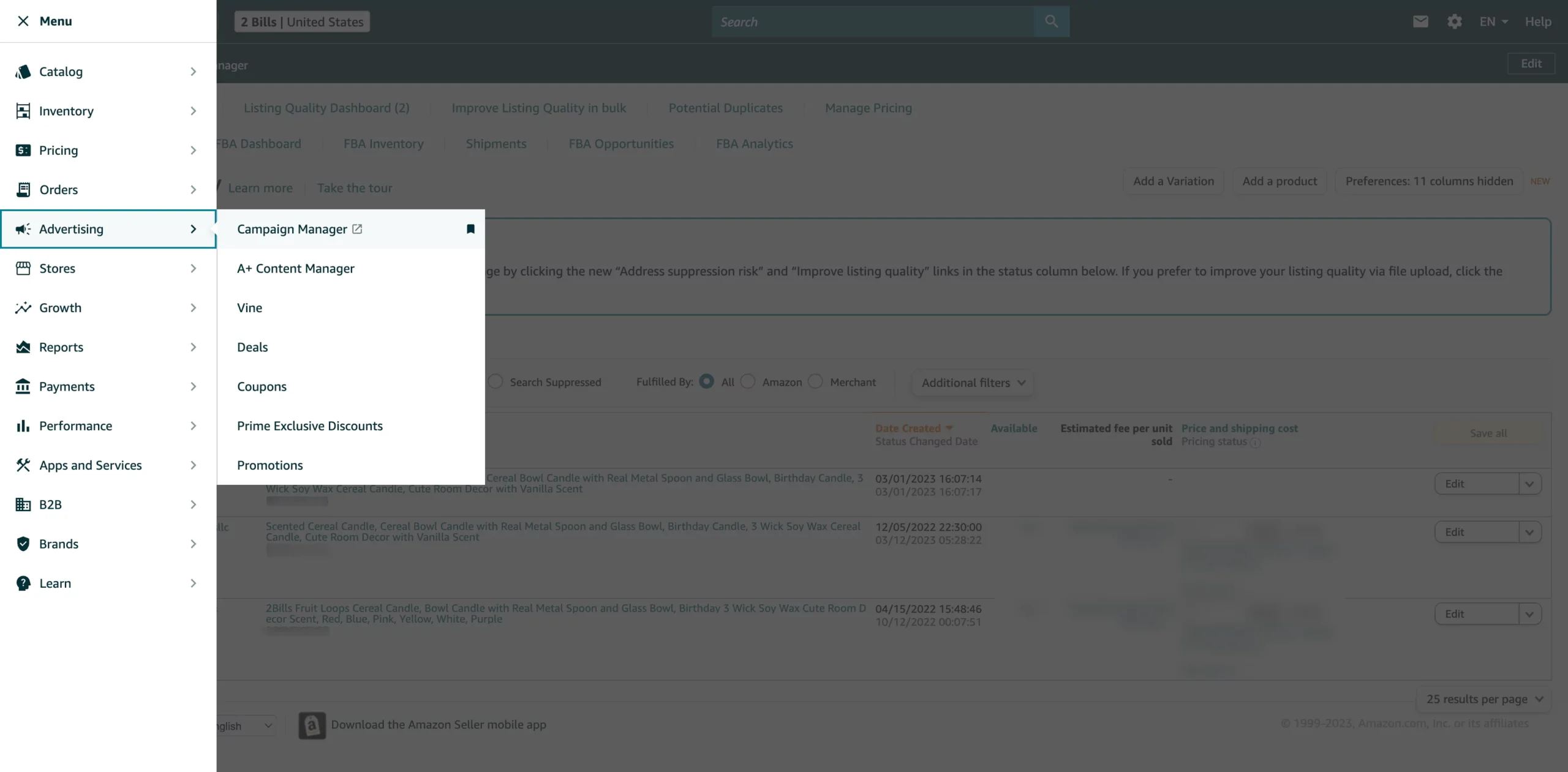
You will first need to log into your Amazon Seller Central account, and then once on the homepage, go to the dropdown menu on the top left corner, scroll down to Advertising, and then choose Campaign Manager. You will come to the Amazon Ads homepage, which is where you can review your campaigns, ad budgets, products that you are advertising for, as well as keyword targeting metrics. From this campaign manager page you will be able to see any of your video ads, sponsored brands ads, sponsored display ads, sponsored products campaigns, and more.
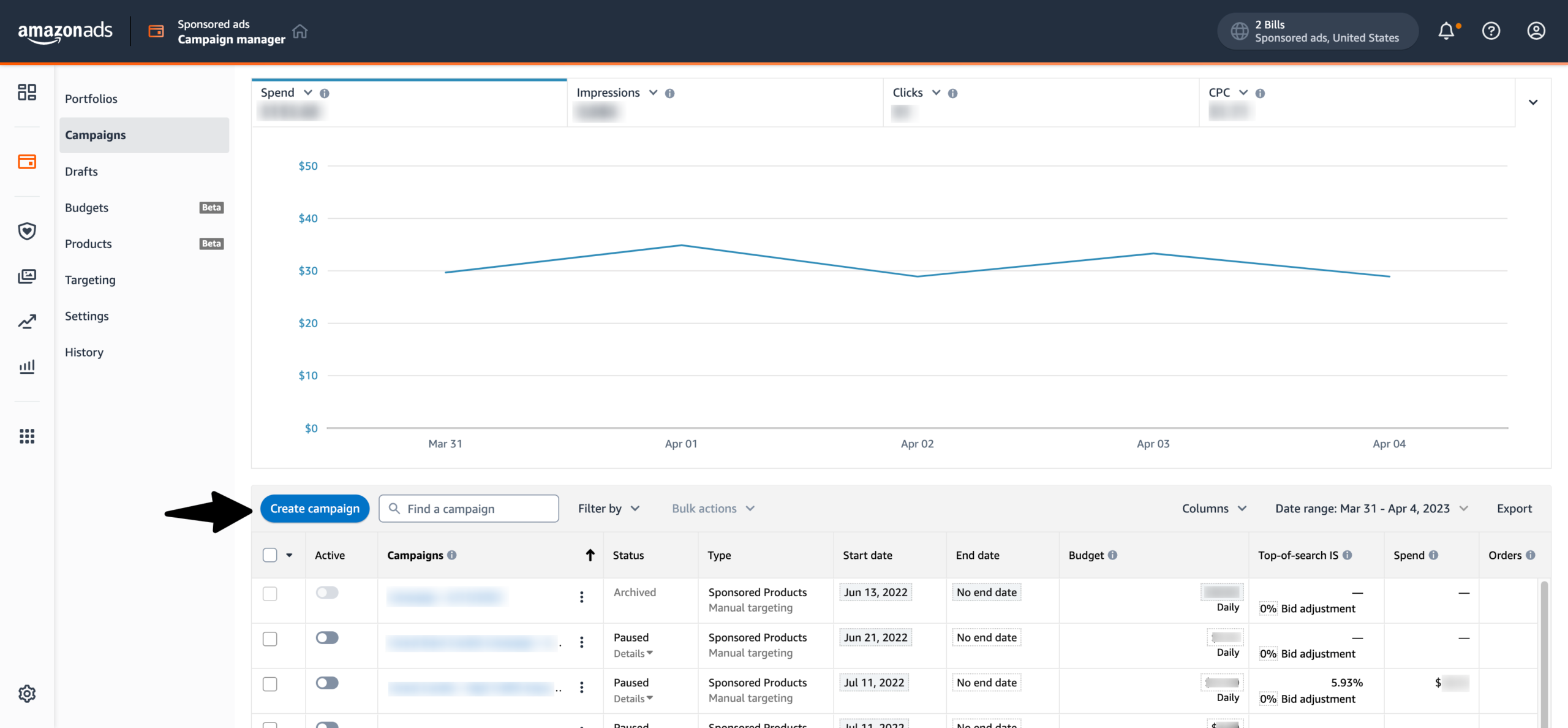
When you are ready to create an advertising campaign, you will select the blue button which says ‘Create campaign‘.
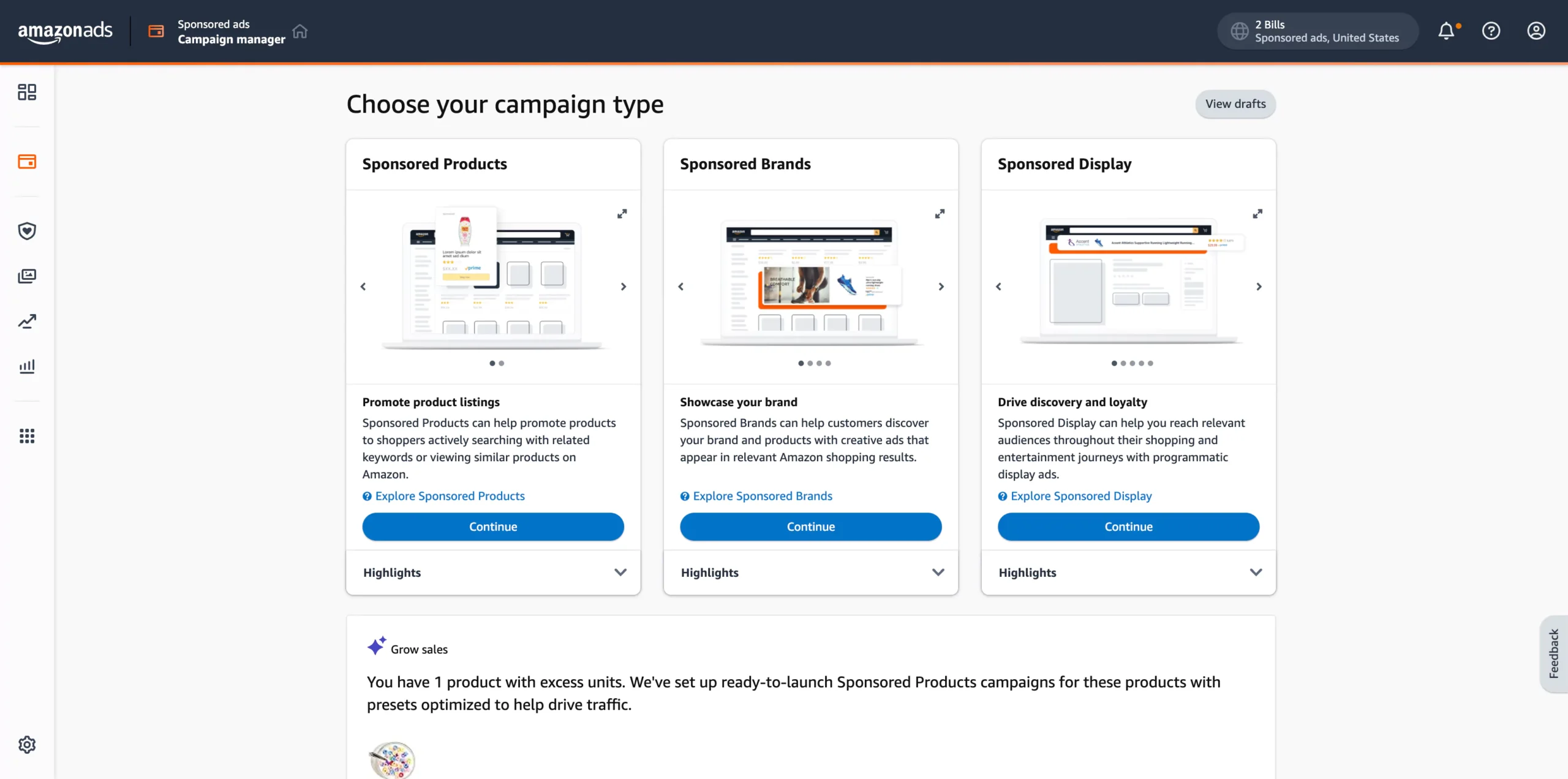
Once you click on that, you will be given the option as to what advertising campaign type you want to create. You can choose between Sponsored Product ad, Sponsored Brands ads, and Sponsored Display ads. The most common ad type will be Sponsored Products, so that is what we will use as an example for this article.
Set Up Your Campaign Budget, Duration, and Targeting
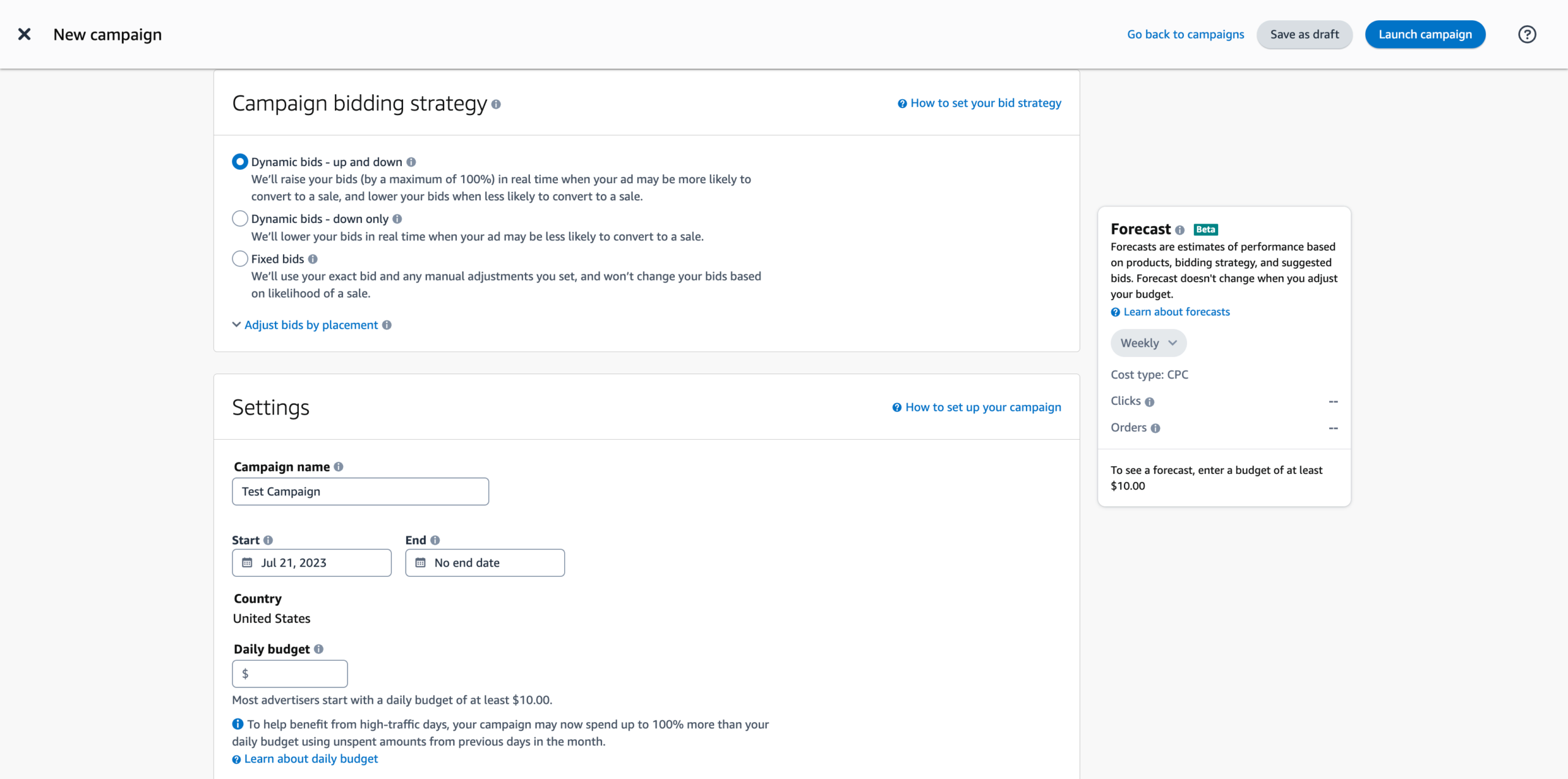
Once you have selected your ad campaign type, you will be given a variety of options and campaign settings to choose from. To set up your campaign budget and advertising campaign duration, scroll down to the ‘Settings‘ section. In this section, you can enter in a Campaign name so you can easily identify the campaign later.
Next, you can set a start and end date for the ad campaign you are creating. It is important to note that it is best for your campaign to run for at least 1 month so that you can assess how it is performing, and then make any necessary changes to it to improve your advertising metrics.
Lastly, you will set a daily budget for the ad campaign. This is the amount that you are willing to spend daily on this specific ad campaign. It doesn’t necessarily mean that you will spend that budget every day, but be wary of how much budget you have for advertising. Some sellers have a daily advertising budget of $5, and others may have $100+. Choose an amount that you are comfortable with, and be sensible as you don’t want to waste all your money on advertising if it isn’t bringing in sales. One of the main pitfalls for Amazon sellers it not having a good grasp on their advertising cost.
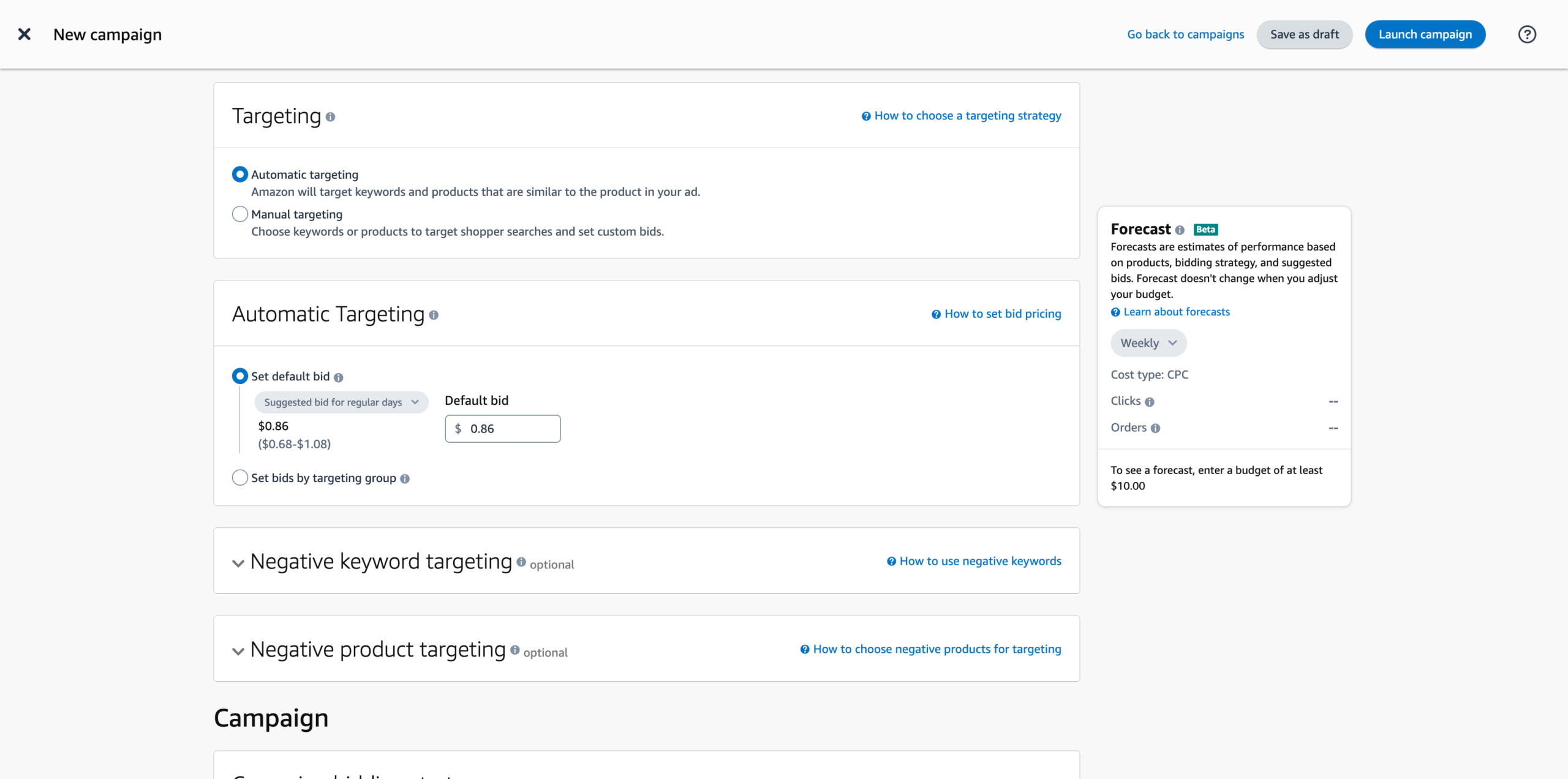
Name Ad Group
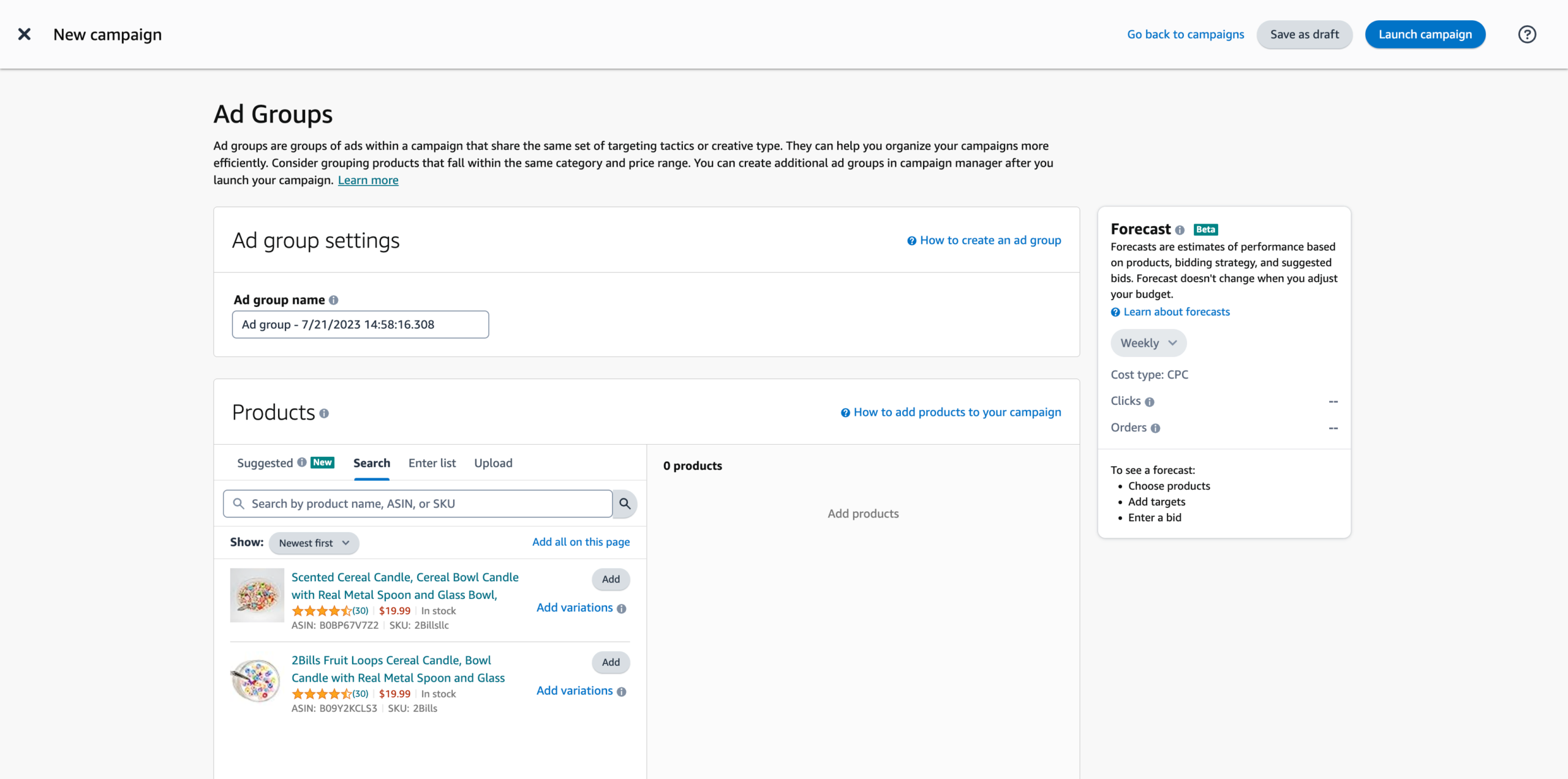
Naming your ad group is an easy step in the process, but it is an important one! During your seller journey you will create multiple ad groups, so naming them is a great way to stay organized and easily manage ads with your campaigns.
Select Your Products You’d Like to Run Ads For
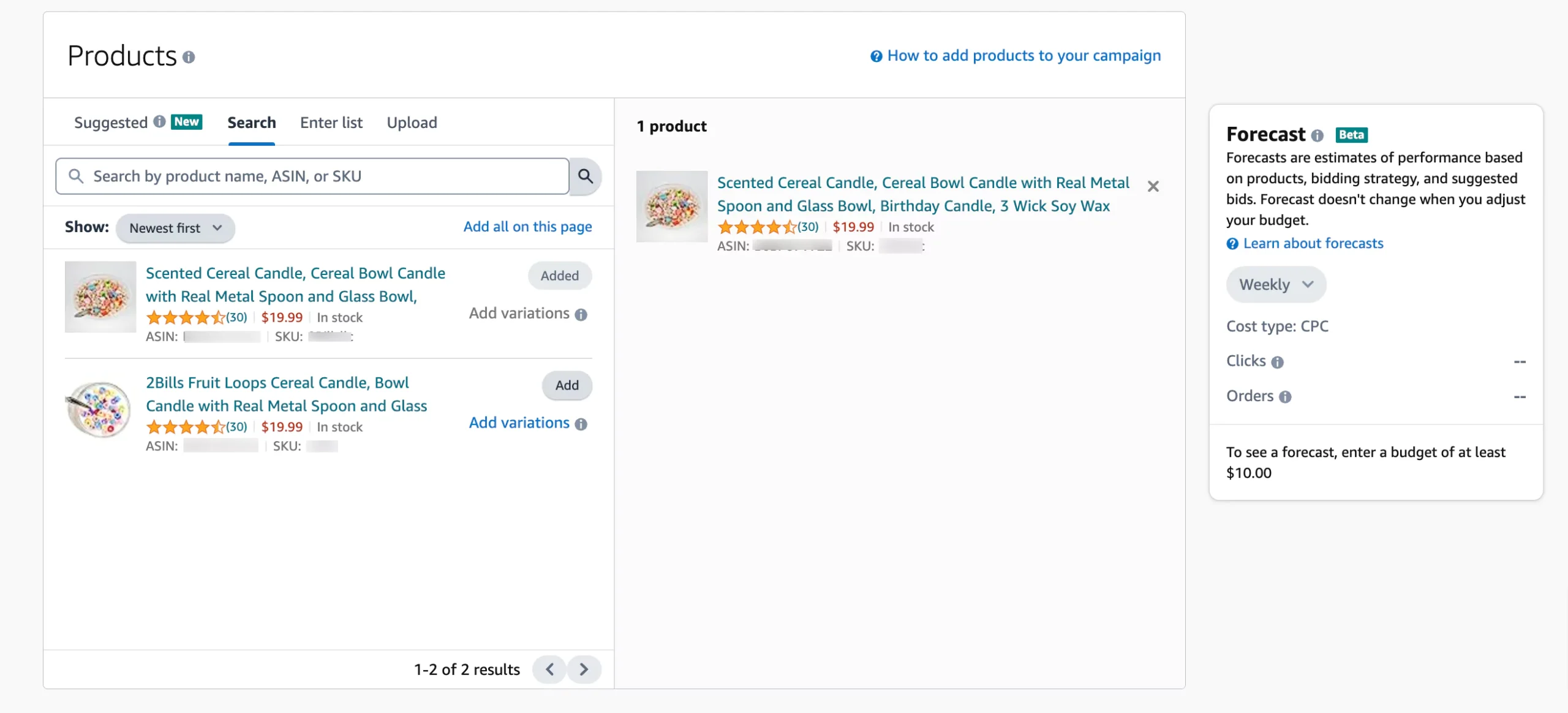
Next, you will select the product that you want to promote with this ad campaign.
It is typically most effective to run separate ad campaigns for each product you are selling. You could run an ad campaign for multiple products you are selling if they are in the same product category, are closely related to each other, and have a similar price point.
Set Your Campaign Bidding Strategy
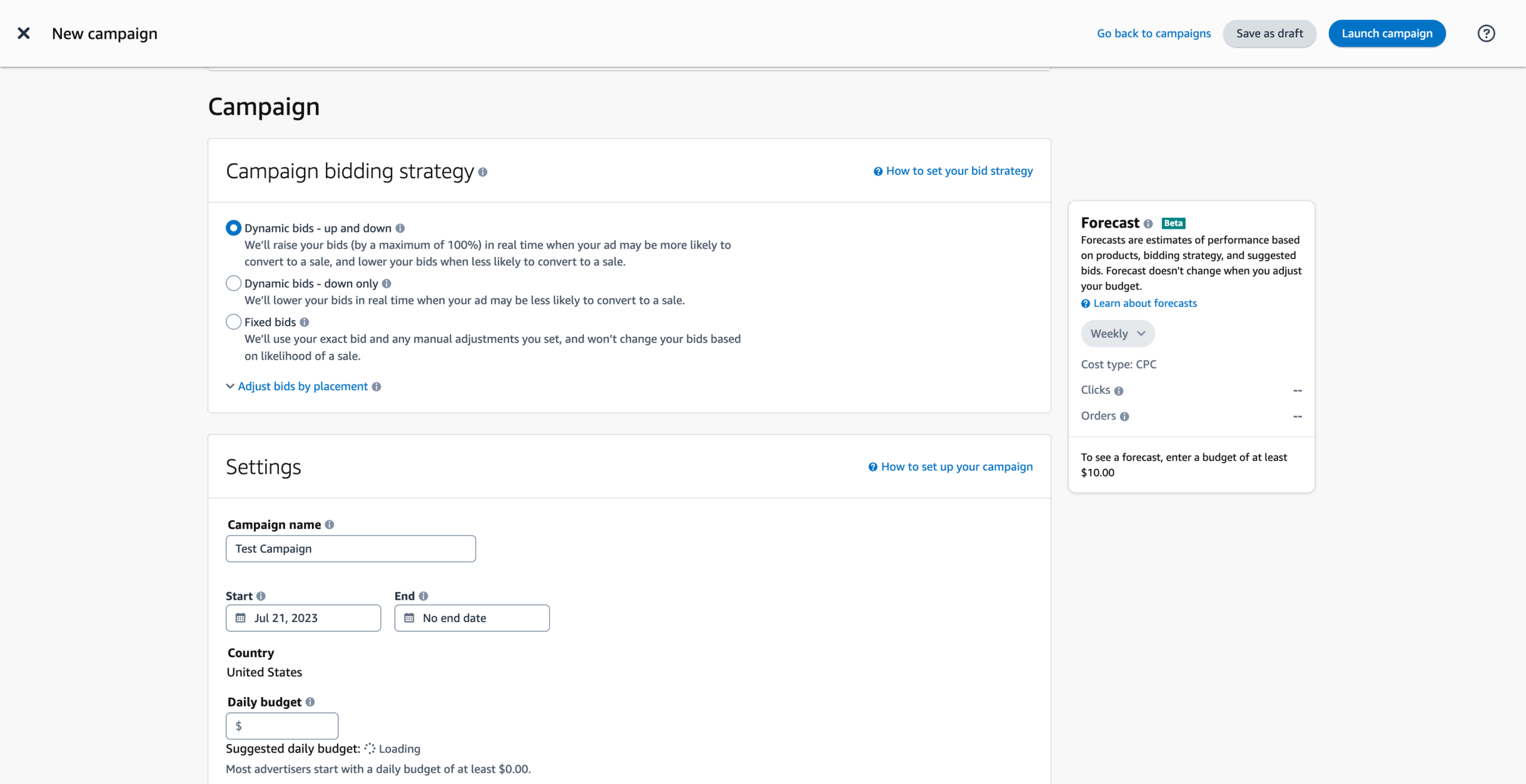
The final step, which is an important one, is deciding what your campaign bidding strategy is going to be. There are a few options to choose from, and you can always change the strategy in the future.
The first option you will see is ‘Dynamic bids – up and down’.This means that Amazon will automatically raise your bids (by a maximum of 100%) in real time when your ad may be more likely to convert to a sale, and Amazon will automatically lower your bids when less likely to convert to a sale.
The second option is ‘Dynamic bids – down only’, which means that Amazon will only lower your bids in real time when your ad may be less likely to convert to a sale.
The final option is ‘Fixed bids’ which means that you will set the exact $ amount you want to bid on a keyword, and that is the only amount you will bid. Amazon will not automatically lower or raise your bid for you.
Once you have finalized those campaign settings, you will next want to work on the ‘Targeting‘ section. You can choose ‘Automatic’ or ‘Manual’ targeting. If you select ‘Automatic’, Amazon will target keywords and products that are similar to the product you are advertising. If it is your first time creating an ad campaign, and you don’t have a good selection of keywords that you want to target, it may be best to try automatic targeting first. However, the better strategy would be making sure to find all of your most relevant keywords that your competitors are getting sales from by using tools such as Helium 10 Cerebro, and then starting with an exact match campaign. After a few weeks of running an automatic targeting ad campaign, you can assess how all the keywords are performing, and then create a manual targeting campaign that only uses the keywords that performed best.
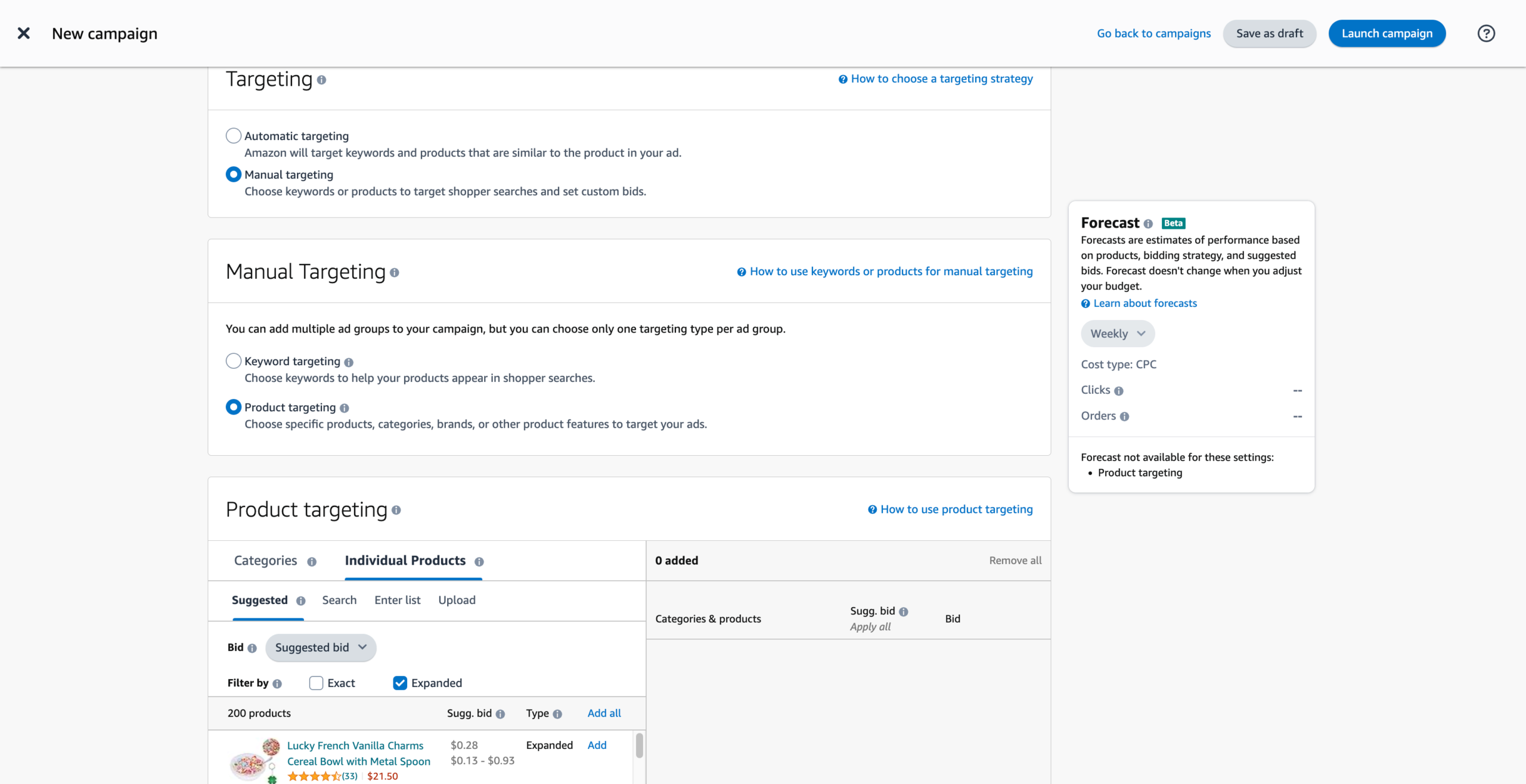
If you select ‘Manual’ targeting, you will have to manually choose keywords you want to target to help your product appear in search results. Alternatively, you can select specific products, categories, brands, or other product features to target your ads.
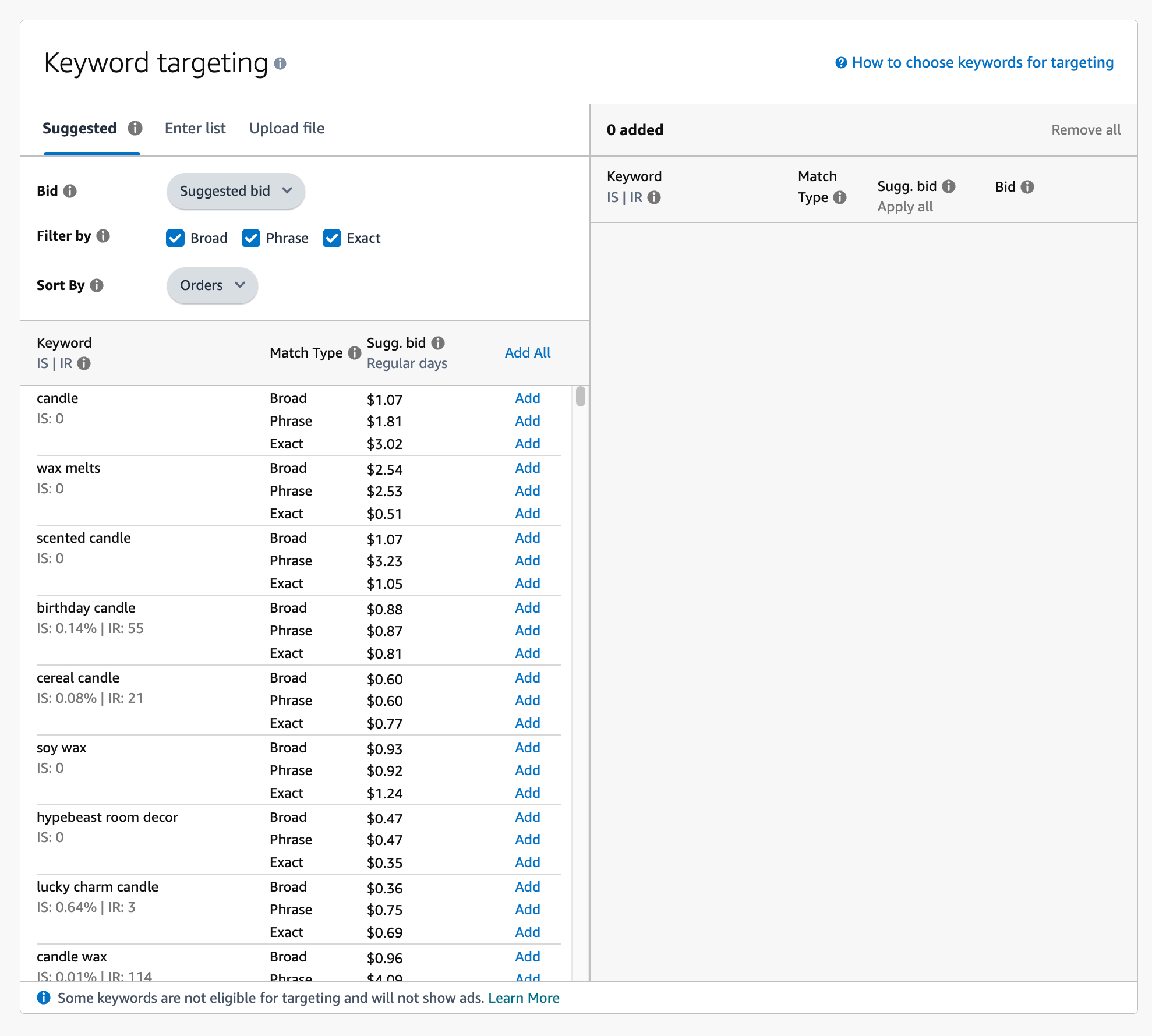
The screenshot above shows what you will first see if you select manual targeting. As you can see, Amazon provides a list of suggested keywords which you can select from. Under each keyword, you will see ‘IS’ and/or ‘IR’. IS stands for Impression Share, which is the % of impressions you are getting for that specific term, relative to the total # of impressions it is generating. The higher IS, the better! IR stands for Impression Rank, which is where your Impression Share ranks against other sellers who are also bidding on that same term. The lower IR, the better!
To the right of each keyword, you will see ‘Match Type‘, broken down into Broad, Phrase, Exact.
Broad match keywords mean that your keyword will be matched to search terms that not only match your keyword, but are also related to the keyword. This can include variations, synonyms and related terms. In this example, we have candle as a keyword. A broad match could include ‘candles’, ‘3 wick candle’ ‘lighters’, ‘home decor’, and ‘aesthetic decor’. Broad matches can be a great way to target keywords that you may not have thought of, but you must be wary that these keywords are also being bid on by other sellers who may be selling a product which is more relevant to that keyword. If you choose a broad match on a phrase such as coffin shelf, keywords such as coffin decor or black shelf might come up.
Phrase match keywords are a bit more restrictive that broad match keywords. Sticking with ‘candle’ as our keyword, examples of phrase match keywords would be ‘scented candle’, ‘soy wax candles’, ‘candle with wood wick’. As you can see, each keyword still has ‘candle’ in the phrase. In phrases such as egg tray, you can see longer tail keywords such as big egg tray, or egg tray
An ideal structure that we teach in PPC Academy for sponsored product ads for your amazon store is starting for each of your product:
- Sponsored Product Exact Match Keyword Campaign
- Sponsored Product Broad Match Keyword Campaign
- Sponsored Product Auto Campaign
- Sponsored Product ASIN Targeting Campaign
- Sponsored Display ASIN Targeting Campaign
You would then have the auto and broad campaigns “feed” newly discovered keywords into your exact match and ASIN campaigns. For example, you could set up a rule where if your auto campaign converts at least twice for the same search term, that you then move that search term to your exact match campaign so that you can hopefully get more consistent impressions on it, and build your sales history for that keyword.
If you have multiple ASINs, you can create sponsored brands campaigns to also be part of the above flow, and use the “broad” and “auto” discovery campaigns to find keywords that you can run video ads or headline search ads to.
Lastly, before adding a keyword to the list of keywords you want to target, you will see ‘Suggested Bid‘. This $ amount is calculated daily (so it is subject to change) and it is based on past bidding activity for ads similar to yours to predict bids that are more likely to win. You can choose to bid more or less, depending on how important that keyword is to you, and how much advertising budget you have to spend. These are notorious for not always being accurate, so take them with a grain of salt.

If you have added all the suggested keywords you want to bid on, or if you have already done some keyword research and know which keywords you want to bid on, then click on ‘Enter List‘. In the text box, you can manually enter in those keywords. If you have already compiled a list of keywords, you can choose to upload that list instead of having to type them out one by one. To do this, go to ‘Upload file‘, next to ‘Enter list‘. Be aware that the only accepted file formats are CSV, TSV, and XLSX.

Negative keyword targeting is optional and can seem confusing to new sellers, but it can be a powerful tool for reducing ad costs. Negative keywords are keywords you select to prevent your ads from appearing on search queries that are not relevant to your product, or are low priority. You can choose to have ‘negative exact’ or ‘negative phrase’ keywords, although negative exact is probably the best choice as you can add negative keywords without excluding you from other keywords you may not want to be excluded from.
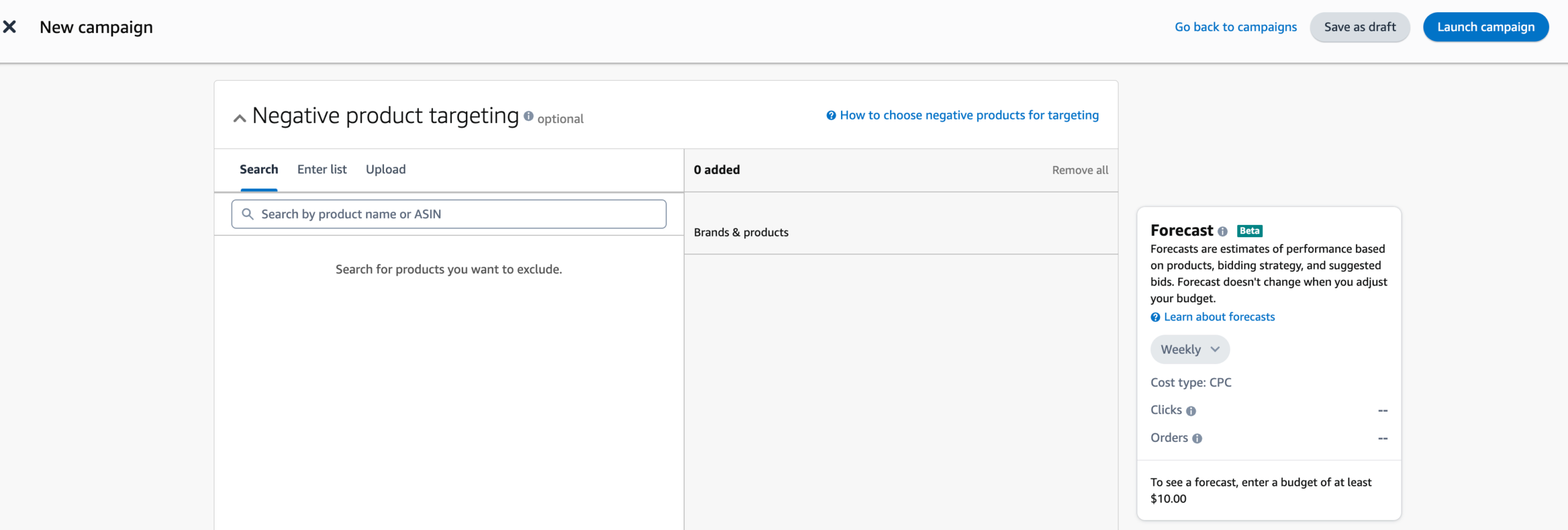
Negative product targeting is very similar to negative keyword targeting. Instead of preventing your ads from appearing on search queries based on keywords, your ads won’t appear when shoppers are looking at products that you have determined to be irrelevant to your own product.
Save and Finish
You have now successfully created an ad campaign on Amazon Seller Central, congratulations! Once you have launched your campaign it is important to review how it is performing and make changes when necessary. Assessing how your ad campaign performs will help you make decisions like targeting new keywords and/or changing your bidding strategy which can help you save a lot of money and maximize your advertising budget.
An important thing to do is monitor your sponsored products ads to make sure you are not wasting money. The most common loss that sellers have is by allowing Amazon to continue to spend on targets and ad groups that are not performing well. One potential rule you should set up is to negative match a keyword that does not seem likely to convert for a sale. For example, you could decide that if a search term gets 30 clicks without a sale, you will negative match that keyword so that Amazon will not spend your budget anymore on that keyword.
Additional Advertising Strategies
While Sponsored Brands and Sponsored Display ads are powerful toolsets in their own right, enrolling in Amazon’s Brand Registry program gives registered sellers a suite of additional high-octane advertising capabilities to truly maximize brand presence.
For brands willing to complete the vetting process, Brand Registry represents an elevated plane of promotion prowess on the world’s top e-commerce platform. A few of the key exclusives available only to approved registrants include:
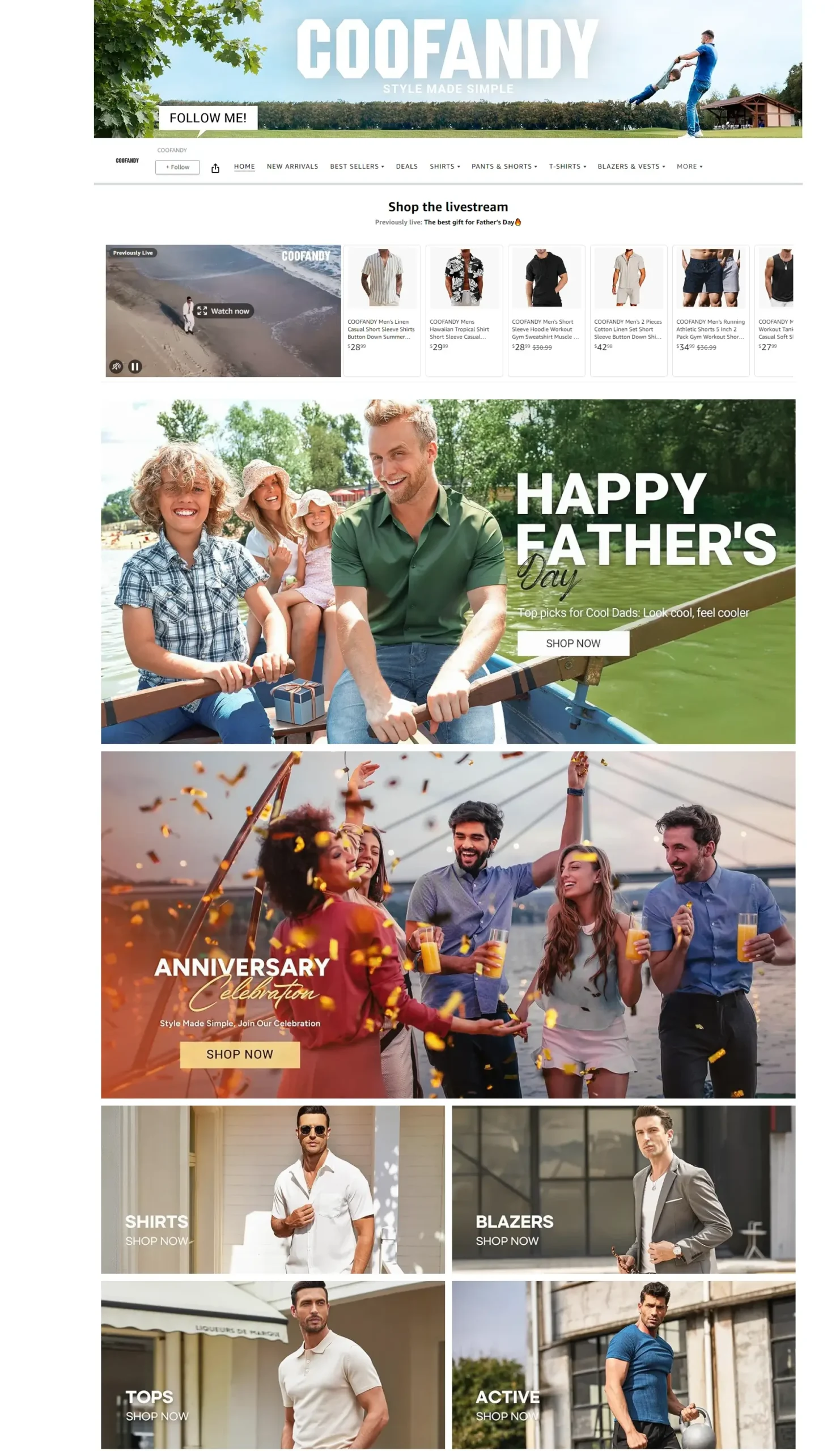
Amazon Stores
An Amazon Brand Store is essentially your own dedicated e-commerce destination hosted right on the Amazon domain. Think of it as a virtual showroom to showcase your products and brand messaging without the distracting clutter of traditional search results.
With an Amazon Store, you get free rein to create an immersive, multi-page brand experience complete with customized imagery, product galleries, videos, and more. This dedicated environment allows you to drive prospects directly to your curated storefront (and with no competitor ads jockeying for attention).
Amazon describes these brand stores as a “self-branded browsing experience” exclusively featuring your products and brand story. Unlike years past when this capability was limited to first-party vendors, any third-party seller can now easily build out a professional Amazon Store for free through the self-service portal.
Take Coofandy’s sleek store layout as a prime example. The visuals, content layout, and overall look-and-feel ooze premium branding while guiding shoppers through the full product catalog and value propositions.
With strategically placed calls-to-action like “Visit the Coofandy store” across product detail pages, brands can drive high-intent traffic directly into this owned storefront experience primed for conversion.
An Amazon Store represents a powerful branding vehicle to move prospects through an edu-taining funnel ultimately culminating in a purchase – all hosted natively on the trusted Amazon domain.
Amazon Attribution
For brand-registered sellers, Amazon Attribution is a game-changing free tool for accurately measuring the revenue impact of your off-Amazon marketing efforts. No more guesswork or throwing ad spend blindly at external channels and hoping something sticks.
Attribution arms you with granular analytics to truly understand how those Facebook campaigns, Google paid search ads, Amazon influencer promotions, and other off-Amazon initiatives are directly driving incremental sales on your Amazon product listings. The detailed dashboards quantify key performance metrics like return on ad spend, new-to-brand orders driven, and sales funnel visualization across your entire external marketing mix.
Instead of operating in the dark, Attribution illuminates which specific channels, creatives, and campaigns are authentically moving the needle for your Amazon topline growth. With this unprecedented visibility, you can scientifically optimize marketing spend and double down on external efforts yielding tangible e-commerce returns rather than just gambling on hunches.
By connecting the dots across your entire end-to-end customer journey, Amazon’s Attribution tool enables data-driven decisions to efficiently scale revenue while eliminating wasteful ad budget allocations. For brand-focused sellers, it’s a transparent view into marketing effectiveness you’d be remiss to ignore.
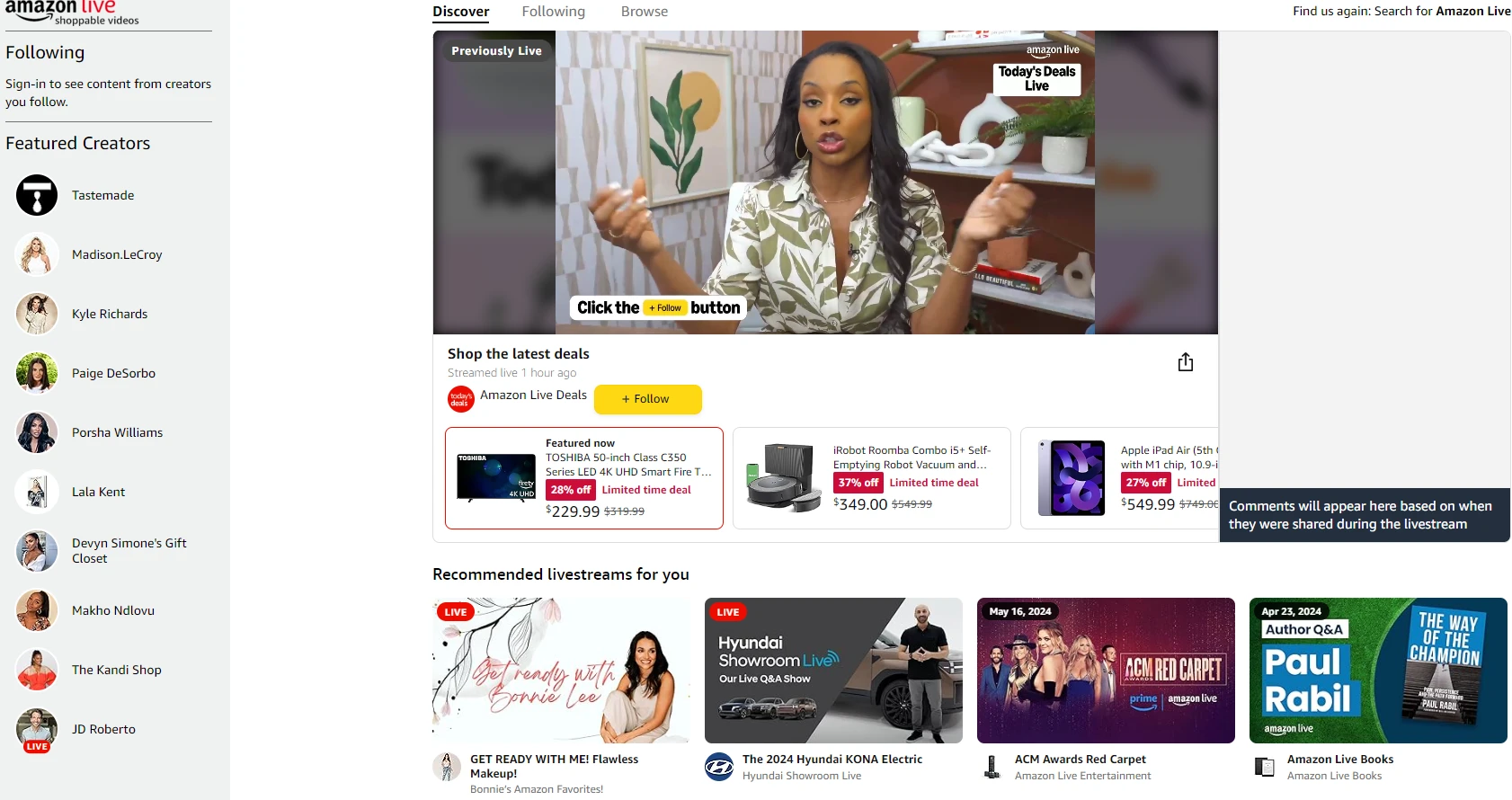
Amazon Live
Amazon Live represents a powerful new channel for brands to forge direct connections with shoppers through engaging live video. With this capability, you can broadcast live product demos, Q&As, influencer collaborations, and more, all streamed prominently on Amazon’s high-traffic homepage and even your own product detail pages.
Instead of relying solely on static detail pages, Live unlocks an interactive digital storefront experience. Your brand representatives or influencer partners can showcase products in real-time, provide in-depth walkthroughs, answer customer questions live, and inject personality that resonates with your audience.
This multimedia experience also allows you to breathe life into product descriptions in an attention-grabbing format. Rather than hoping written copy alone paints a sufficiently compelling picture, Live empowers you to tell visually rich stories that spark excitement and urgency to buy.
For brands aiming to humanize their presence on Amazon’s marketplace, Live streaming opens up inventive new possibilities to creatively showcase offerings, leverage influencers, solicit feedback, and ultimately drive more sales. With instant shoppability baked right into the Live video experience, you can capitalize on impulsive purchasing behavior when product desire is at peak levels.
Conclusion
Understanding how to set up Amazon Seller Central ads is crucial for any Amazon seller looking to enhance their advertising efforts and drive business growth on the platform. With various ad types available, including Sponsored Products, Sponsored Brands, Sponsored Display, and more, sellers can choose the most suitable options based on their marketing goals and target audience.
Amazon’s advertising platform provides valuable insights and tools to manage ad campaigns effectively. From budget allocation and targeting options to keyword selection and performance metrics, sellers can make data-driven decisions to optimize their advertising strategy and maximize product visibility.
As an estimated 75% of Amazon sellers use Amazon ads, the platform’s seamless integration and high purchase intent of shoppers make it a compelling choice for advertising. By mastering the art of setting up campaigns in Amazon Seller Central, sellers can capitalize on this advertising opportunity, expand their brand reach, increase sales, and ultimately achieve e-commerce success on the world’s largest online marketplace.
Amazon PPC is one of the most difficult things to master in the entire journey, so it’s important to keep educating yourself on the ever-changing landscape of Amazon advertising.
To boost your Amazon sales and success even further, make sure to subscribe to the Serious Sellers Podcast where guests are interviewed frequently by Amazon PPC experts.
Frequently Asked Questions
Achieve More Results in Less Time
Accelerate the Growth of Your Business, Brand or Agency
Maximize your results and drive success faster with Helium 10’s full suite of Amazon and Walmart solutions.

